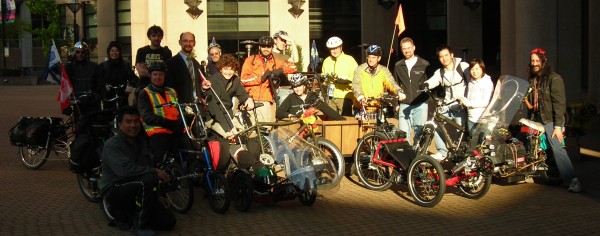Justin Lemire-Elmore
Movie in the Park


On Saturday night there is a chance to view the first ever bicycle-in movie screening featuring a short film "The Cat Returns". This will be hosted by our good friend Bruce Lau who has built a collapsible 14 foot screen that straps to his ebike; and the projector, sound system, and lighting for the show are all powered from circuits Bruce made that run off his ebike battery pack.
If you are up for doing something unique this Saturday then pack your blanket, some popcorn, and come join us. We will be meeting up at our store (4570 Main St.) at 8:30pm, and then riding en masse to an undisclosed public lot where the stage will get setup for an outdoors movie theater.
Connector Standards

As of June 2009 we have now standardized all of the hall connectors on our motors and motor controllers to the plastic style (SM series from JST) and pin-out used in the eZee kits. We've discontinued the so called mini-XLR format used on the Crystalyte system because of complications sourcing this connector for other vendors, and we want all the ebike parts we supply to be interchangeable whenever possible. The latest shipment of Crystalyte disk compatible hub motors which we have in stock now uses this flat plastic connector from JST, as does the latest batch of rear Nine Continent motors. We plan to embrace this connector pinout as a standard for all hub motors and controllers that we carry going forwards.
Controller Status
Aug 2nd Controller Status Update: We now have the infineon immediate start controllers available in both 20 and 35A models to use with both the Nine Continent and Crystalyte hub motors.
As many people have noticed, we don't currently have any stock of immediate start Crystalyte motor controllers, whether in the 20A or the higher current 35 and 48A models. We have been working on sourcing a higher end replacement of these for quite a while and hoped to have something comparable to offer by now, but several unexpected setbacks including parts shipments getting lost in transit have held things back. If everything goes well at this point we are expecting to have them available before the end of July. Until then, we don't have much to offer for 'complete package' systems other than the eZee kits.
Critical Mass - Friday June 26th, 2009, 5:30-8:30pm
If you've ever wondered what it's like to be surrounded on all sides by cyclists as far as the eye can see, then show up at the Vancouver Art Gallery on the last Friday of June. This ride caps off June, Bike Month, with a bang.
Car Free Day - Sunday June 14, 2009 - All Day

The annual car-free festival has grown by leaps and bounds since a few visionaries first opened up Commercial drive to the walking public several years ago. Last year we participated with a "Car Free Vehicle Show" on a section of Main Street to good effect, introducing a lot of people to the car free transportation possibilities that exist with electric assist bicycles and tricycles. Our cargo trike was a huge success ferrying people up and down the road all day long. This year we'll be bringing our fleet and also a whole pile of unicycles too, always something new to try. The road closure has expanded to cover Main Street all the way to King Edward. We'll likely be stationed around 18th and Main.
Kilowatt-Hour Ebike Ride and BBQ - Friday June 12th, 2009

The last three kWhr electric bicycle rides have been great fun, with upwards 14-18 people showing up for longer trips along the water and winding up for drinks and food at the Jericho Sailing Club. This June it's going to be extra special with a bunch of us bringing portable barbeques and finishing the ride with a full fledged summer picnic on the beach. So come all and help make it the largest group ebike ride yet, leaving 6pm on June 12th at the Vancouver Public Library, and bring barbeque food if you got it.
VEVA REV! 2009 - Saturday June 6th, 10am-4:30pm
The Vancouver Electric Vehicle Association's annual EV show is happening this coming Saturday at the Burnaby Sports Field. This is a free event for the public to check out all kinds electric cars, scooters, skateboards, and bicycles, ranging from commercial booths to home-made conversions. There is a small track for you to test ride the various contraptions and lots of people to meet.
Cross Canada E-Bike on Display: June 4th - Sep 30th, 2009
Finally, last night (June 2nd) was the grand opening of a new exhibit at the Museum of Vancouver called "Velo City, Vancouver and the Bicycle Revolution".. The purpose of the show is to tell the often overlooked stories of the various bicycle cultures here and how they are shaping up to redefine our city life. Among the many items on display, from the land speed record Diablo, to the freak bikes, to courier fixies, BMX's, and trials bikes, is the weathered and dirty but still working semi-recumbent Xtracycle conversion that traveled 7100km across Canada last summer! Thanks to all the people who contributed to purchasing the Big Dummy frame and who by so doing encouraged keeping this bike in tact. Less than a year later it is already in a museum as a piece of history.

The exhibit runs for three months until the end of September and is well worth checking out.
eZee 48V compatibility
Although we initially had the eZee controllers modified and advertised as being 48V capable, there have been enough failures at this point that we are going to back down and only suggest them for 36V operation. Under heavy load conditions at 48V, such as going up a long steep hill full throttle, there is a possibility of a mosfet frying. This didn't happen in our original 48V testing as we were using 8AH NiCad packs which would sag to about 43V at 20A currents. But the trend recently has been for "48V" 16 cell LiFePO4 batteries (more properly called 52V packs), and these deliver a higher voltage to the controller under load which can more easily put it over the edge.
For customers currently running their eZee kits at 48V, we recommend using a Cycle Analyst to limit the current draw to 15 amps max. When we receive the new controllers alluded to in the previous paragraph and have validated their robustness at 48V, then we give the option of exchanging these for the eZee controllers so that you have the 48V capability originally implied.
June Abounds
June is bicycle month in Vancouver and this year is off to a rocking start with one of the warmest and sunniest summer weather systems we've had in ages. The bike paths are overflowing with happy riders and new commuters, and tons of bicycle themed events are taking place around town


 Canadian
Canadian




